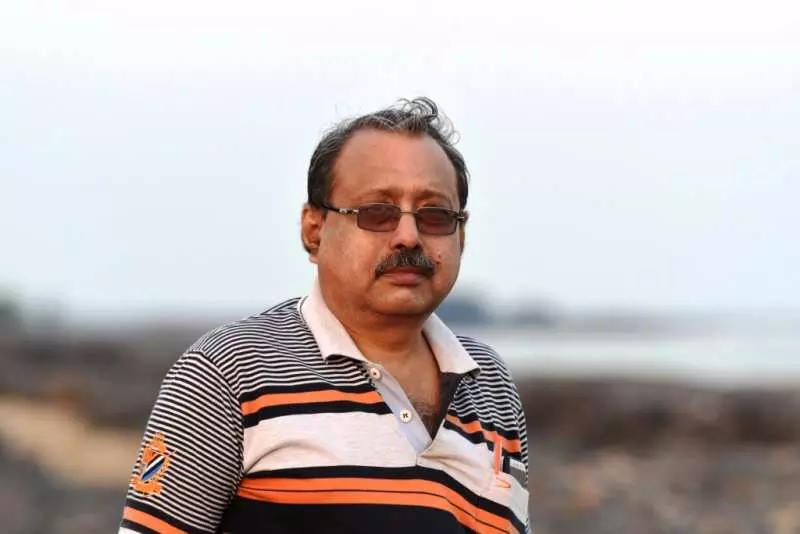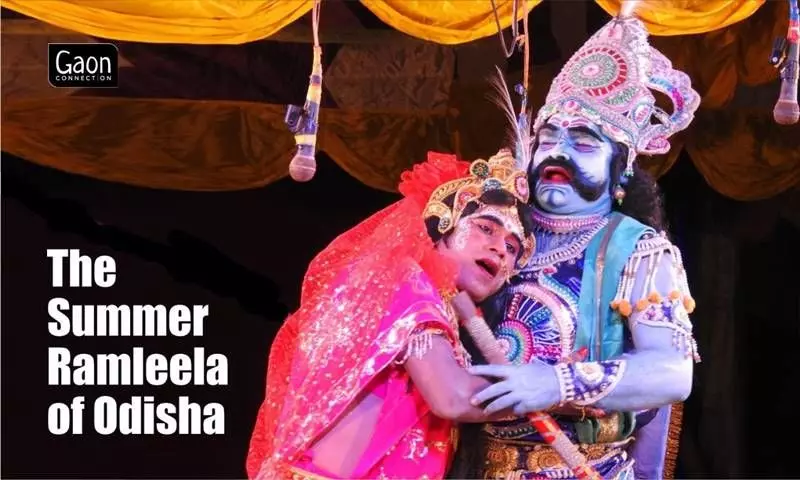Odisha's Summer Ramleela returns after 2 years of COVID exile
The summer ramleela celebrations in Odisha are back after a two-year hiatus due to the pandemic. This month-long revelry is a source of income for women self-help groups who tailor costumes for the artists who perform the Ramayan epic on an open air stage. A report from the villages of Jajpur where the summer ramleela is underway.
 Ashis Senapati 6 May 2022 11:54 AM GMT
Ashis Senapati 6 May 2022 11:54 AM GMT

With stylised movements, ornate costumes, traditional music, plenty of dances, songs and plots full of conflict and humour, Jatra in Orissa has remained not only a mere entertainment but also an essential institution for educating and elevating the people in general. All photos by arrangement
Ramleela usually heralds the onset of winters in India when performances of the Ramayana are enacted with songs, story-telling and drama. However, the eastern state of Odisha has a long tradition of summer ramleela, commonly known as jatra, which is performed in the villages.
After a gap of two years due to the COVID pandemic, the summer ramleela is back and villagers are rejoicing in it.
Typically, the jatra season in Odisha commences during the autumn and wraps up by the onset of monsoon. The summer ramleela, which involves a vibrant mix of colourful attires, music and dance is performed on an open-air stage, which is usually a raised platform around which the audience sits. This year, the summer ramleela began on April 10, on Ram Navami festival, and it will continue till the last week of June or the first week of July.
This annual jatra is not only a source of entertainment for the rural people but also a means of their livelihoods. Thousands of villagers are involved directly or indirectly in this theatrical performance.
History and origin of Jatra
It is believed that the jatra originated in Bengal in the 15th century as a result of the Bhakti Movement, in which devotees of Lord Krishna went singing and dancing in processions and often went into a trance. This singing with dramatic elements gradually came to be known as jatra, which means "to go in a procession."
Also Read: Odisha: From dehumanising street acts to weaving mats, a tribal community has travelled a long way
"In the absence of a powerful Indian city theatre (with the exception of a few in Kolkata, Mumbai, and parts of Tamil Nadu), folk theatre has kept the rural audiences entertained for centuries and has played an important part in the growth of modern theatres in different languages," the Britannica section on Folk theatre of the South Asian arts reads.
"With stylised movements, ornate costumes, traditional music, plenty of dances, songs and plots full of conflict and humour, Jatra in Orissa has remained not only a mere entertainment but also an essential institution for educating and elevating the people in general," mentions a research paper titled Jatra – people's theatre of Orissa, which features on the Union government's Indian Culture website.
Summer ramleela as a source of livelihood
Excitement is palpable in Haripur and Narasinghpur villages of Jajpur district in Odisha. This annual jatra is not only a source of entertainment for the rural people but also a means of their livelihoods. Thousands of villagers are involved directly or indirectly in this theatrical performance.
Rural women who are members of the local self help groups (SHGs), make the costumes for the jatra performers.
"It has now become a family tradition to make jatra dresses during ramleela. It adds income to the family. We cannot afford to neglect it. Despite the invasion of TV and the Internet, ramleela jatra survives due to its religious appeal in rural areas from which we are eking out our livelihood," Anapurna Sahoo, a jatra dressmaker from Haripur village, told Gaon Connection. She also works as the secretary of Jagannath SHG.
Also Read: Odisha: Mayurbhanj's tribal families toil in the mahua season while the middlemen flourish
Prasant Padhi, the Jajpur district project manager of Odisha Livelihood Mission said the project has helped women gain financial autonomy, which was earlier enjoyed only by the male dress makers in the two villages of Haripur and Narasinghpur.
Sahoo earns almost Rs 10,000-Rs 30,000 in a season of ramleela jatra. According to Annapoorna, as many as 50 women members of her SHG are presently engaged in making different clothes for the jatra performers to wear.
"Two years ago, the officials of the government-managed Odisha Livelihood Mission provided us a loan amount of one lakh rupees to start a jatra dress and costume making unit in the village," informed Sahoo. "We make costumes for Radha, Krishna, Raja, Ravan, Ram, Sita, Hanuman and other mythological characters. We also make coats, crowns, coloured umbrellas, hats and accessories," she added.
Samarendra Sahoo, a dress maker from Haripur village told Gaon Connection that his entire household has been busy stitching for the last four months.
"We couldn't earn any extra income for the last two years as the jatra was suspended. Now, I along with my wife and three children have been working to make dresses for kings and soldiers of the jatra. We barely sleep as this time of the year provides us with an opportunity to better our lives," Samarendra said.
Government support to the women dress-makers
Kalpana Nayak, a resident of Narasinghpur village in Jajpur district, told Gaon Connection that with the assistance of the state government's scheme, more women are coming forward to work as independent dress makers and this has empowered them.
Rural women who are members of the local self help groups (SHGs), make the costumes for the jatra performers.
"It is the only time of the year when their products sell like hot cakes. A jatra dress maker earns around Rs 10,000 to Rs 30,000 during the month-long ramleela festivities," Nayak said.
When contacted Prasant Padhi, the Jajpur district project manager of Odisha Livelihood Mission said the projecthas helped women gain financial autonomy, which was earlier enjoyed only by the male dress makers in the two villages of Haripur and Narasinghpur.
"To help women and girls of the areas, two years ago we formed women SHGs and producers groups in Haripur and Narasinghpur to help nearly 50 women to earn money by making costumes for the jatra artists under the 'Regeneration of Traditional Industry' programme," the official told Gaon Connection.
"The Odisha Livelihood Mission is also helping them by directly linking these women self help groups with the bigger markets," he added.
#Odisha Jatra ramleela
More Stories




